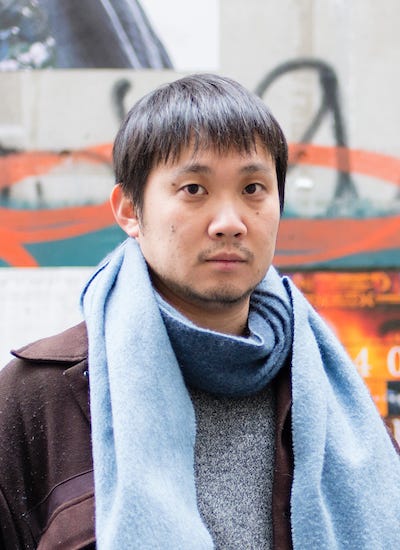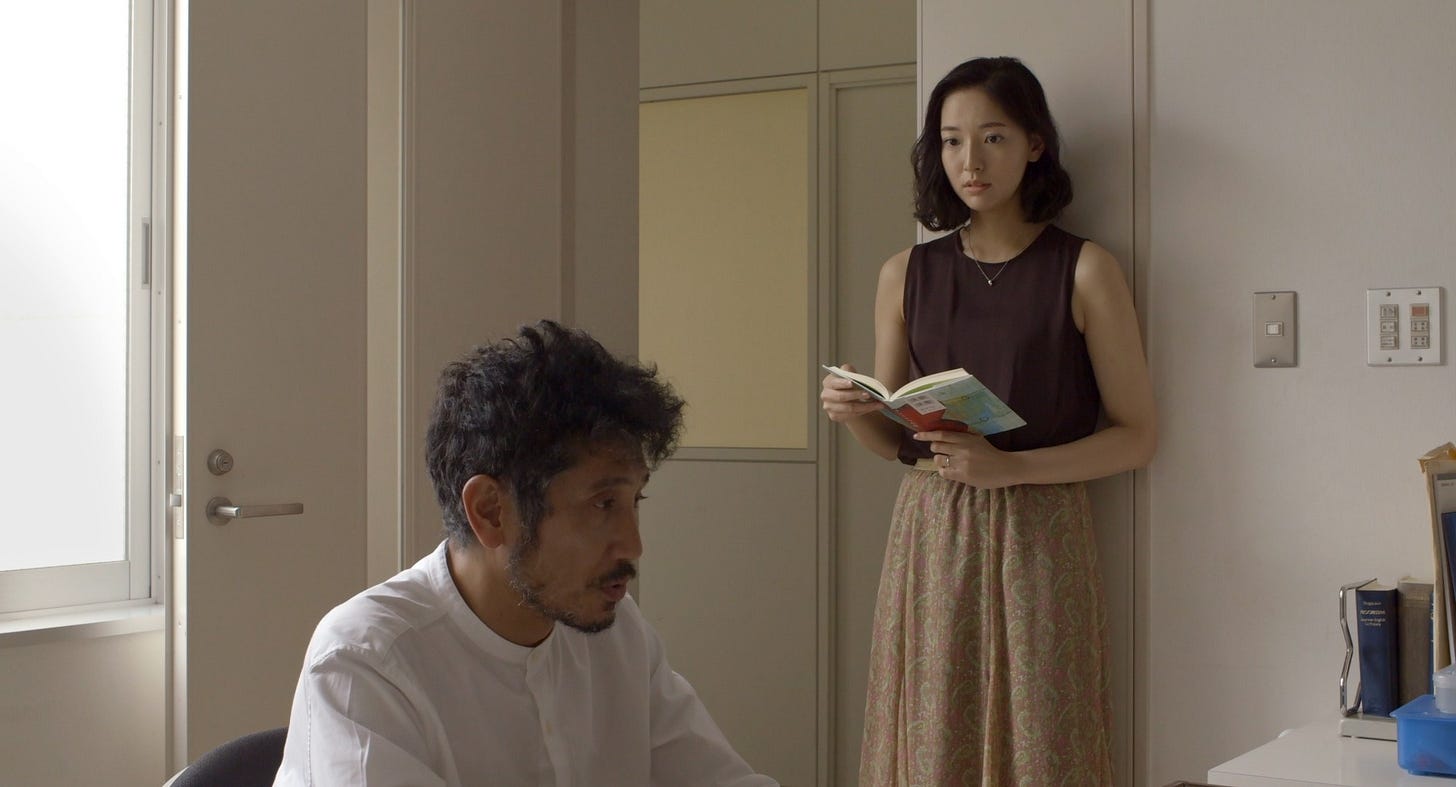012: Ryusuke Hamaguchi
An interview with director Ryusuke Hamaguchi, whose new film 'Wheel of Fortune and Fantasy' has its world premiere at this year's Berlinale
Welcome to Tune Glue, a newsletter that’s run in conjunction with Tone Glow. While the latter is dedicated to presenting interviews and reviews related to experimental music, Tune Glue is a space for interviews with artists of any kind. These interviews could be with filmmakers, video game designers, perfumers, or musicians who aren’t aligned with what Tone Glow typically covers. Thanks for reading.
Ryusuke Hamaguchi
Ryusuke Hamaguchi is a Japanese filmmaker who began making films in the early 2000s but became internationally recognized in 2015 for his 317-minute film Happy Hour. He followed that with the short film Heaven Is Still Far Away in 2016 and the feature film Asako I & II in 2018. His newest film, Wheel of Fortune and Fantasy, is premiering at this year’s Berlinale and is composed of three short episodes (of a series containing seven) that deal with “coincidence and imagination.” As with his prior films, it moves patiently and is inspired by the films of Éric Rohmer, tenderly portraying the lives of its characters and the emotions that underline their interpersonal relationships. Joshua Minsoo Kim talked with Hamaguchi on March 3rd, 2021 to discuss his new film, his process of directing his actors, and more.
Joshua Minsoo Kim: Your films largely focus on characters, both their individual lives and their relationships with others. It’s clear that you care a lot about the actors you choose. I was wondering how you decided on the actors that are in Wheel of Fortune and Fantasy. Were there specific actors you were seeking out?
Ryusuke Hamaguchi: We have eight main cast members in this film and four of the cast members are people who I was working with for the very first time, so for that there was an audition process. Now, the four other main cast members are people with whom I’ve worked before on previous projects, so I had wanted to work with them on a project where it allowed for more time with them in production.
With the actors and actresses I’ve worked with before, I had them in mind already during the screenplay writing. I write the script from the perspective of, “I know this person, I know what he or she is like as a person, I know how they work, and I would like to see a new side from them.” It’s my way of expanding what I’ve already seen.
Can you provide a specific example of an actor you’ve worked with previously and how you wanted to expand what they would do in this film?
The most prominent and probably the most easy-to-understand example would be in the second episode where we have the college professor Segawa. The actor who plays it is Kiyohiko Shibukawa and he rarely plays an intellect in the films that he does. He usually plays a yakuza or yakuza-like character—someone who’s likable in an old bro type of way. But there is an earnestness and an innocence to him that I know of that I wanted to bring out through this character that he depicts.
It’s interesting to hear how you think about the actors and who they are as people, and how you allow for themselves to come through in their roles. Do you identify closely with any of the characters in either this film or any previous film?
I would say that I really, truly identify with all of the characters that I write. There are bits and pieces of me in all the characters—otherwise, you wouldn’t be able to write a screenplay. The approach I take is that I’m re-enacting the scene as I write it myself, and so these characters that I depict and that I write of course do not take the same actions that I do. They’re very different people from who I am, but I’m writing from the sense of, “What would I, myself, do in this situation?”
I would say that if I were to draw a common thread between myself and the characters I write, it would be a certain sense of seriousness and earnestness. This is in all of the characters that I depict. They stick to their principles, and others may regard that as something frivolous, and that creates a certain sense of comic relief. The only character that I really have nothing in common with is in the second episode, the college boy Sasaki. He was a very difficult character to write for me because there’s nothing in common between myself and him, and it was the very first time that I wrote that kind of character—someone I had nothing in common with.
Was there anything you did to get in the mindset of this character then?
In my filmmaking there is first form, and there is structure. The form that this storyline took was that of non-realism, let’s say. But then, you infuse it with a certain sense of realism in what the actor says and the way he delivers his lines. That character, Sasaki, is put in this story as a certain function. However, I allow for a sense of freedom as to how that person says that line. In creating that part of the dialogue, I drew back on other things that I have read, on other actors I’ve met, including the actor [Shouma Kai] who plays this character in particular. I would ask this actor—or remember what I’ve asked of the other actors in the past—in terms of how they would approach saying that line or piece of dialogue.
With all this talk of acting, I know that you played an acting role in your 2003 film Like Nothing Happened. You’ve not acted otherwise—is there no interest for you to be an actor in your films?
That was a student film that I did while I was still in school as part of the club activities that I was involved in. I would say that I don’t dislike acting but it was a very different approach than you might imagine in Like Nothing Happened. I was surrounded by non-actors who didn’t have much experience in acting. It was a very rambunctious, active, assertive character. What I was trying to do in the ensemble was to draw a reaction from my cast members—it was more about eliciting expressions of unease from my co-actors. I was there more as a “function”; I wasn’t acting as an outlet for emotion in any way. But I seemed to like that, and it was a really relaxing process for me to be a cast member in that way.
That seems to relate to how you allow for freedom in your script so that your actors can express themselves in the way they want. Is there a certain line or scene in Wheel of Fortune and Fantasy that you intentionally left open so you could see how actors would play it out in the way they best saw fit?
Rather than talking about one individual scene, because I use the same method in all the scenes that I do, I will talk a little more about my method and process in directing my actors. There’s a very interesting duality to my process, that being I allow no leeway for freedom, and at the same time I do. Meaning, there is of course a rehearsal process in my filmmaking, and this is what we call in Japanese hon-yomi (本読み), but we have the actors read the script over and over again to the dot. Not one word or instance can be changed, and they have to have fidelity in terms of timing and cadence and breath and where you pause and so forth. We do that over and over. And we have them read the dialogue in a way that is very flat and very devoid of emotion.
After we have gone through that process, then we go on set and I have the actors do it in any way they want to do it. Meaning that whatever they emit in words stems from their emotion in the moment. I would say that on set, there is freedom in that way, yes. So I do guide them in terms of how I block them and where I want them to move, but the rest is really left up to them in terms of emotion, but only after the rehearsal process.
Thank you for explaining all that. You’ve done short films in the past, you had some early on, you had Heaven Is Still Far Away a few years ago, and others as well. How was it creating a new film composed of multiple short films? I know that you have seven total short films planned in this series too, so I’m wondering what your process was in terms of weaving all these stories together.
The very succinct answer to your question would be Éric Rohmer. I value short films as a form of filmmaking and I understand that he did as well. I had the chance to speak with his editor Ms. Mary Stephen and I remember us talking about Rendez-vous in Paris and that was three short films bound together to form a feature-length film. I thought, “Oh, that’s interesting. So that’s how you would be able to create an outlet in terms of exhibition, to let it go into the market” because it’s not very possible to put a short film alone in exhibition, right?
You mentioned the fact that there’s going to be seven short pieces included in this work as a whole, and it hearkens back to Rohmer’s work where he had these overlying themes. We have the Tales of the Four Seasons and his Six Moral Tales, and so I follow along that line by making here stories about coincidence and imagination.
I know our time is coming to an end, and I wanted to ask one question that I ask everyone: What’s one thing you love about yourself?
(thinks). I suppose it’s my stubbornness and my inability to change. I think it is a fault but it has also helped me build my life as well, so I suppose it would be that.
Can you give an example of what you mean by that?
If I had been less stubborn and more willing to change, it would have afforded me more chances to actually make the types of films that I wanted to make. However, I don’t think the choices that I’ve made were mistakes—I accept them as well.
Thank you for reading the twelfth issue of Tune Glue. Let’s all learn to accept our mistakes.
If you appreciate what we do, please consider donating via Ko-fi or becoming a Patreon patron. Tune Glue is dedicated to forever providing its content for free, but please know that all our writers are paid for the work they do. All donations will be used for paying writers, and if we get enough money, Tune Glue will be able to publish issues more frequently.




